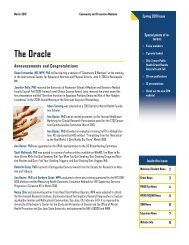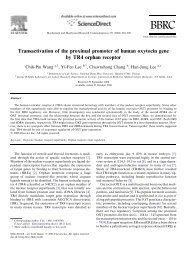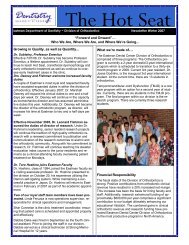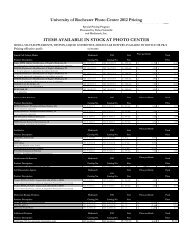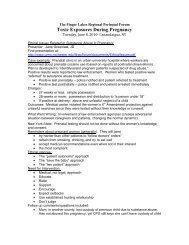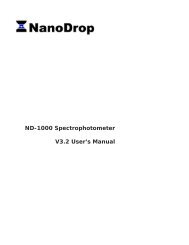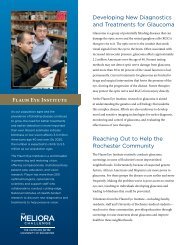Conservative Management of Pelvic Organ Prolapse
Conservative Management of Pelvic Organ Prolapse
Conservative Management of Pelvic Organ Prolapse
Create successful ePaper yourself
Turn your PDF publications into a flip-book with our unique Google optimized e-Paper software.
672 Trowbridge and Fenner<br />
evaluating a pessary protocol. They reported<br />
that hormone replacement therapy (HRT)<br />
did not predict successful pessary fitting.<br />
Moreover, the health <strong>of</strong> the vaginal epithelium<br />
was recorded in 75 <strong>of</strong> these women,<br />
and no correlation was found between current<br />
hormone replacement status and vaginal<br />
abrasions rates. However, the incidence<br />
<strong>of</strong> vaginal abrasions was increased significantly<br />
as the vaginal epithelium became<br />
thinner This study points out that it is difficult<br />
to control for various aspects <strong>of</strong> HRT<br />
and its role in maintaining healthy vaginal<br />
epithelium with pessary use. These factors<br />
include the type, route, frequency, and<br />
length <strong>of</strong> treatment <strong>of</strong> hormone therapy.<br />
Most experts would advocate local estrogen<br />
therapy in pessary users provided that there<br />
are no contraindications to its use. Recent<br />
studies have shown that oral HRT/estrogen<br />
replacement therapy (ERT) provides no<br />
functional improvement <strong>of</strong> the lower urinary<br />
tract. 16 To definitively answer the question<br />
<strong>of</strong> estrogen use and pessaries, we need trials<br />
on type, route, frequency, and so on.<br />
Choosing a Pessary<br />
There are 2 general categories <strong>of</strong> pessaries<br />
for the management <strong>of</strong> pelvic organ prolapse:<br />
1) support pessaries and 2) spacefilling<br />
pessaries (Table 2). Support pessaries<br />
such as the ring pessary use a spring mechanism<br />
that rests in the posterior fornix and<br />
against the posterior aspect <strong>of</strong> the pubic<br />
symphysis. 17 The space-filling devices, such<br />
as the cube pessary, function by creating<br />
suction between the device and the vaginal<br />
walls, or by merely occupying a space larger<br />
than the genital hiatus as demonstrated by<br />
the donut pessary. The Gellhorn pessary is<br />
thought to function through a combination<br />
<strong>of</strong> these latter 2 mechanisms.<br />
Currently available pessaries are made <strong>of</strong><br />
flexible silicone or less frequently latex<br />
material. The advantages <strong>of</strong> silicone or other<br />
inert plastics include convenient patient insertion<br />
and removal, lack <strong>of</strong> allergenic potential,<br />
greatly reduced odor absorption, and their<br />
durability. Rigid pessaries are no longer recommended,<br />
and if found on a patient’s<br />
examination, they should be removed.<br />
There are 2 generally accepted approaches<br />
to choosing and fitting a pessary to manage<br />
symptomatic pelvic prolapse. Most commonly,<br />
a physician will choose a pessary<br />
based on the specific support defects (complete<br />
uterine prolapse, anterior, apical, or<br />
posterior wall defect). A second approach<br />
involves using the same pessary for all<br />
defects.<br />
Currently, neither approach has been proven<br />
more effective than the other. A survey<br />
given to members <strong>of</strong> the American Urogynecologic<br />
Society found that a majority <strong>of</strong><br />
responding physicians (78%) tailored their<br />
choice <strong>of</strong> pessary to the specific support<br />
defect. The findings <strong>of</strong> this survey point to<br />
the fact that the pessaries most commonly<br />
in use are the ring, Gellhorn, and the donut<br />
pessary. What specific defects are most<br />
improved by mechanical devices is a question<br />
for which there is no clear data on<br />
which to make clinical recommendations.<br />
Table 1 reports the pessary choices <strong>of</strong> a<br />
survey <strong>of</strong> members <strong>of</strong> the American Urogynecologic<br />
Society.<br />
Despite the lack <strong>of</strong> evidence that any 1<br />
pessary is best in managing a patient’s<br />
symptoms, most experts would agree on<br />
some basic tenets. Anterior vaginal wall<br />
defects (cystoceles) are best managed with<br />
ring pessaries or lever pessaries (Smith-<br />
Hodge). Stage II apical (middle) compartment<br />
defects (uterine, vaginal vault, enterocele)<br />
are also well suited to management with ring<br />
pessaries. Gellhorns are best suited for stage<br />
III or stage IV uterine prolapse or vaginal<br />
vault prolapse. The donut pessary can also<br />
be helpful in managing complete uterine<br />
prolapse or vault eversion. Posterior vaginal<br />
wall defects have traditionally not been felt<br />
to be as adequately managed with pessaries.<br />
This is likely the result <strong>of</strong> the design <strong>of</strong> most<br />
pessaries, which function through either the<br />
support <strong>of</strong> the pessary resting against the<br />
pubic symphysis and anterior or apical<br />
compartment. For this reason, the donut, a



